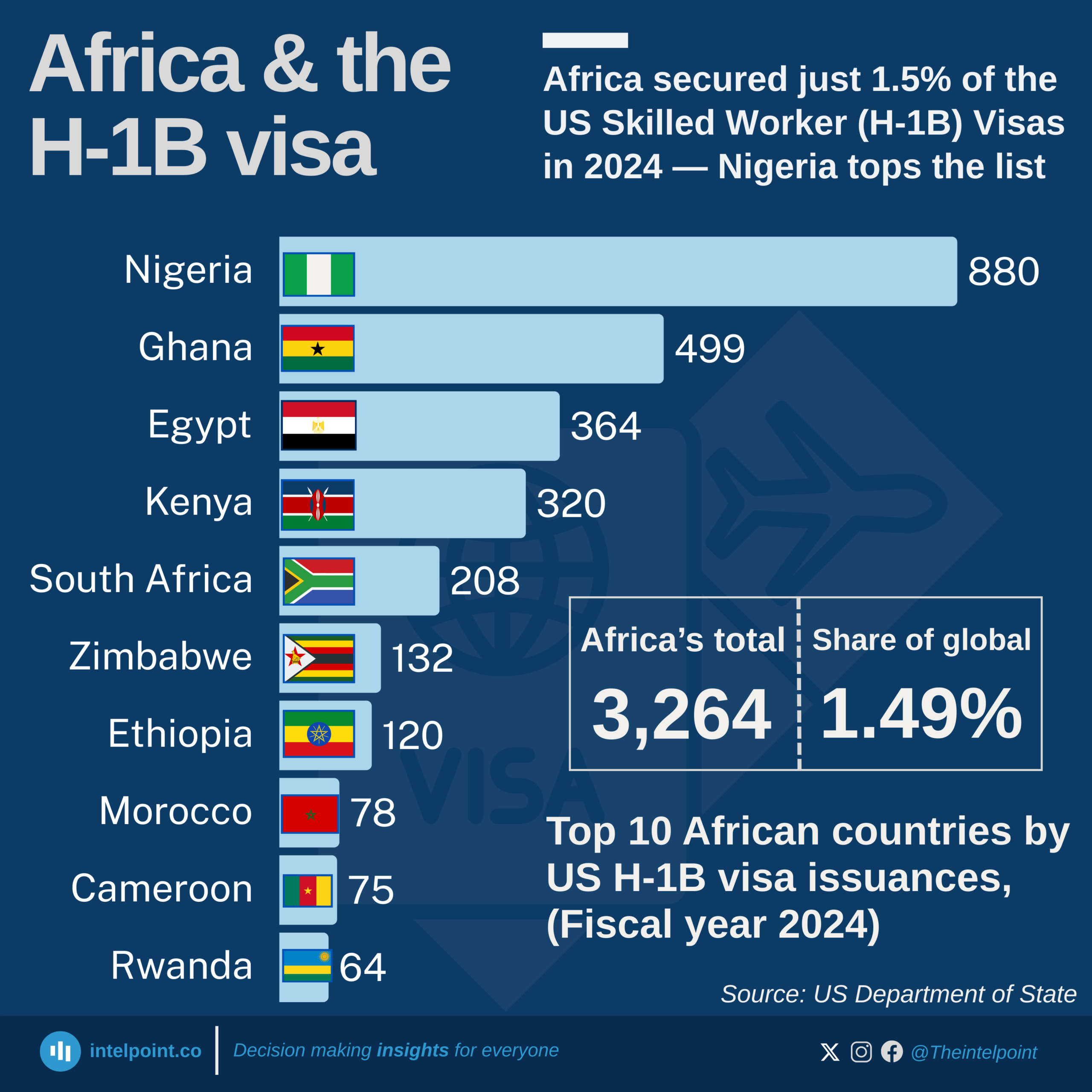US employers could pay an estimated $326.4 million to hire African professionals under President Donald Trump’s new $100,000 H-1B visa fee, according to an analysis by Finance in Africa.
This marks a sharp increase from the previous total cost of $5.55 million to $14.7 million and could reshape how American firms source talent from the continent.
We derived the estimate by multiplying the 3,264 H-1B visas issued to 51 African countries in 2024 (US State Department data) by the new $100,000 fee, and comparing it with the same total multiplied by the old fee range of $1,700–$4,500, depending on company size.
Trump announced the fee last week, effective September 21, 2025, framing the move as a crackdown on “abuse” of the skilled-worker visa programme.
The H-1B visa, which allows highly skilled foreign professionals to live and work in the US for up to six years, has long been a critical hiring channel—particularly for technology and engineering firms.
According to tech analysts and immigration lawyers on the social media platform LinkedIn, the increase presents a significant shift in US immigration policy that will have substantial economic implications
“The new fee raises costs from a few thousand dollars to a flat $100,000 per visa, payable by the employer at the time of filing,” said Dieudonne Dany Mbarga, a Ghana-based financial analyst.
Mbarga noted that the hike forces companies to make hard decisions: “Large tech firms may absorb the cost for exceptional talent, but it will be prohibitive for smaller start-ups and for non-tech sectors like healthcare and education that also rely on these visas.”
A critical pathway under pressure
Created in 1990 under President George H.W. Bush, the H-1B programme was designed to attract highly skilled workers—scientists, engineers, educators and mathematicians—to fill specialised roles. Although temporary, it gives US employers a three-year hiring window, extendable to six.
Tech giants such as Amazon, Google and Meta have used the programme extensively to bring in engineers and developers. But with a flat $100,000 fee, a route once prized for cost efficiency risks becoming a barrier.
The top H-1B occupations include application and systems software developers, computer systems analysts and architects, electronics engineers, management and operations research analysts, and computer programmers.
“This is not just a fee; it’s a strategic barrier that will force organisations to rethink how they source talent and manage international assignments,” said Kanishka G, an India-based immigration lawyer.
She added that the policy would likely push employers toward domestic hiring or alternative visa categories, and may prompt companies to invest and hire in countries with more favourable immigration policies.
Fumnanya Okeleke-Kooper, Senior Product Manager at African e-transport firm Ampersand Energy, said the order changes the value proposition for US employers: “For years, the US has been the dream destination for skilled workers, especially in tech. Now companies will be forced to ask: Is this employee worth $100,000 to the government?”
Africa’s marginal but growing footprint
Africa accounts for a small share of H-1B visas. Last year, the continent received 1.5% of total issuances (3,264 visas) compared to India’s 150,647 (68.5%) and China’s 31,735 (14.4%). Still, African issuances have surged 318% since 2021.
With Africa’s tech workforce expanding—from 690,000 professional developers in 2020 to 716,000 in 2021 (Google Africa Developer Report)—and a projected 1 billion youth by 2050 (World Economic Forum), the region is emerging as a global talent pool.
Policies like Trump’s fee hike could slow access to US opportunities just as African countries intensify their investment in digital skills. Kenya, for example, made coding compulsory in primary schools in 2023, and Nigeria has followed suit.
“Remote workers outside the US become even more valuable. The same product managers, engineers, designers, and analysts that companies wanted in Silicon Valley can now be engaged from Lagos, Bangalore, Nairobi, Kigali, or Warsaw, with only occasional travel,” Okeleke-Kooper of Ampersand Energy said.
He noted that labour costs tilt in favour of global teams; without relocation fees and US overheads, skilled professionals abroad look cheaper—almost like arbitrage.
The cost impact by country
Under the old fee structure, hiring African professionals on H-1B visas cost employers a few hundred thousand to a few million dollars in total. At $100,000 per visa, the bill skyrockets. Here is the cost breakdown of the top 10 African countries.
| Country | 2024 H-1B visas | Old cost range | New cost |
| Nigeria | 880 | $1.49m–$3.96m | $88m |
| Ghana | 499 | $0.85m–$2.25m | $49.9m |
| Egypt | 364 | $0.62m–$1.64m | $36.4m |
| Kenya | 320 | $0.54m–$1.44m | $32m |
| South Africa | 208 | $0.35m–$0.94m | $20.8m |
| Zimbabwe | 132 | $0.22m–$0.59m | $13.2m |
| Ethiopia | 120 | $0.20m–$0.54m | $12m |
| Morocco | 78 | $0.13m–$0.35m | $7.8m |
| Cameroon | 75 | $0.13m–$0.34m | $7.5m |
| Rwanda | 64 | $0.11m–$0.29m | $6.4m |
“The immediate effect may be a financial windfall from each approved visa, but if the fee successfully discourages large numbers of applicants, total revenue could end up lower than projected,” Mbarga, the Ghana-based financial analyst, added.












